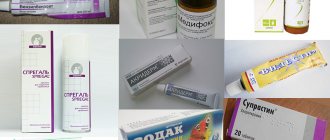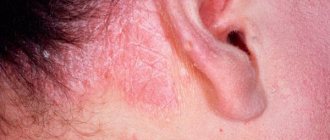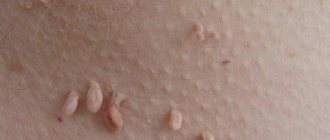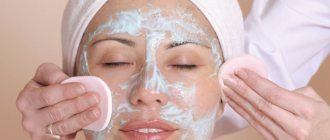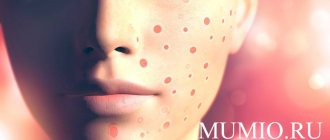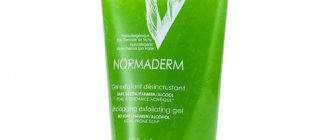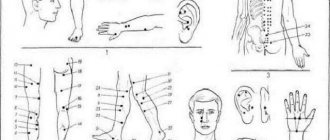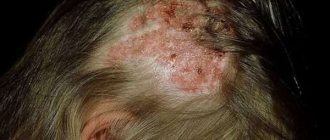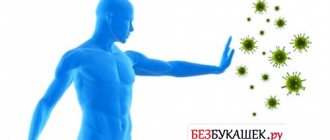Seborrheic dermatitis affects 5% of the population. This is a chronic inflammatory skin disease associated with disturbances in the functioning of the sebaceous glands. Seborrhea can affect all areas of the body where these glands are concentrated (scalp, face, behind the ear, and in rare cases, the chest area and the area between the shoulder blades). Men, adolescents, and people with endocrine disorders are prone to such dermatitis. Seborrhea on the face can be recognized from a photo, but the treatment of the disease should be prescribed by a doctor, focusing on its causes.
What kind of disease is this?
Seborrhea occurs when the sebaceous glands malfunction.
They produce a secretion that removes toxins, but at the same time a water-fat layer is formed, which is necessary to protect against drying out.
With seborrhea, the quantity and quality of the secretion produced changes, which causes disturbances in the microflora of the skin. Its protective functions weaken, creating a favorable environment for infections and inflammation.
The areas where the problem is concentrated are called seborrheic zones. Most often this is the face, scalp, shoulders, back and chest .
Diagnostics
First of all, the doctor collects an anamnesis. Then the risk factor for developing the disease, nervous disorders, genetic predisposition, living and working conditions are determined.
Laboratory tests are prescribed:
- Blood chemistry, which allows you to determine the functioning of internal organs, liver, pancreas, biliary tract, and obtain an informative assessment of the metabolism of proteins, lipids, and carbohydrates. Cost of analysis: from 2 thousand rubles.
- Hormonal blood test to evaluate the functioning of the thyroid gland. The cost of the study is from 3 thousand rubles.
- Trichogram , with its help the condition of hair and skin is assessed. The cost of the procedure is from 3 thousand rubles.
- Ultrasound of the thyroid gland , gastrointestinal tract (if necessary). Cost from 2 thousand rubles.
Classification
There are several forms of seborrhea:
- Dry.
- Fat.
- Mixed.
- Dry seborrhea occurs due to decreased function of the sebaceous glands. The skin and hair become too dry, resulting in itching, dry dandruff, and the hair structure is destroyed, which leads to hair loss. With the dry type of seborrhea, the skin feels tight.
- In most cases, oily seborrhea is diagnosed. Its appearance is due to increased activity of the sebaceous glands. Excessive sebum secretion is more pronounced on the scalp, chin, forehead, back and chest. The characteristic seborrhea itching occurs, the pores expand, acne forms, and hair begins to fall out. Oily seborrhea is a common occurrence in adolescents when puberty begins.
Photo of oily seborrhea on the skin of the face
- The mixed form shows signs of two at once - oily and dry. Both types can appear in one place at the same time.
Possible complications
The lack of comprehensive treatment and ignoring the clinical signs of a fungal disease always leads to the development of complications . As the pathology progresses, in addition to premature hair loss, partial or complete baldness, the patient faces:
- dermatitis or eczema;
- the appearance of ulcers and boils;
- the appearance of acne;
- damage to other areas of the skin.
Dry seborrheic dermatitis of the scalp is not considered a contagious disease, but not a single person is immune from this problem . The likelihood of developing a pathological process can be minimized if you adhere to a number of recommendations.
Dermatologists advise strictly following the rules of personal hygiene, being careful when choosing shampoos, not forgetting about physical activity and leading a healthy lifestyle.
Seborrhea of the scalp
Oily seborrhea of the scalp is easier to diagnose, as it manifests itself quite clearly.
The hair becomes untidy in appearance, begins to become unpleasantly shiny, and dandruff with very large scales forms. Dry seborrhea of the scalp is expressed by excessive dryness and brittle hair. Dandruff flakes are very small, so at first they are completely invisible.
Seborrhea of the scalp: photo
The danger of dry seborrhea is that at the initial stage the symptoms are mild, so treatment begins after more noticeable complications arise. Video:
How to treat seborrheic dermatitis
Treatment of seborrheic dermatitis on the face requires a multifaceted approach and a long period of time. Treatment is carried out both locally with shampoos and ointments, and internally with injections and tablets.
Groups of drugs prescribed for seborrheic dermatitis:
- antihistamines and hyposensitizing agents;
- antifungal drugs;
- glucocorticoid drugs;
- keratolytic agents (zinc preparations, salicylic acid);
- antibacterial medications.
Antifungal drugs
They form the basis of the treatment of seborrheic dermatitis. They stop the intensive reproduction of the Malassezia fungus, thereby promoting recovery. Antifungal drugs are available in the form of shampoos, ointments, and tablets. For mild and moderate forms, the doctor recommends local treatment, that is, ointments or shampoos. For severe and extensive forms of seborrheic dermatitis, systemic use of antifungal medications is usually prescribed.
Antifungal medications are clotrimazole, ketoconazole, fluconazole. They can also be produced in combination with glucocorticoids.
Antihistamines
This group of drugs is prescribed to reduce itching, redness and swelling. Drugs from this category are prescribed in tablet form for no more than 7 to 10 days. Antihistamines include clemastine, chloropyramine, and loratadine.
They have a pronounced antipruritic effect and relieve inflammation. Hyposensitizing agents include calcium gluconate and sodium thiosulfate. These medications are prescribed as intramuscular or intravenous injections.
Keratolytic agents
These drugs are prescribed to soften and reject horny scales and plaques. Preparations of salicylic acid, zinc, and urea are used as keratolytic agents. They complement the main treatment of seborrheic dermatitis with antifungal drugs.
Glucocorticoid drugs
These drugs are prescribed for severe inflammation. For seborrheic dermatitis, glucocorticoid drugs are used in the form of creams and ointments for external (local) use.
In severe cases, they are prescribed systemically in tablet form. These drugs include beclomethasone and hydrocortisone. Very often they are produced in a combined form together with antifungal agents - beclomethasone + clotrimazole, or together with salicylic acid - mometasone + salicylic acid.
Antibacterial agents
This group of drugs is prescribed for complications of seborrheic dermatitis with a bacterial infection. For this purpose, antibiotics from the tetracycline series (methacycline), as well as combination drugs such as oletethrin and metronidazole, are prescribed. Antibiotics are initially prescribed in a loading dose, then the dose is reduced.
For example, treatment starts with 1,000,000 units (action units) per day, and then moves to 250,000 units.
Seborrhea on the face
Oily seborrhea on the face is often accompanied by acne, comedones and ulcers.
In place of the ulcers, due to the accumulation of sebum, cysts called atheromas can subsequently form. Oily seborrhea is more common in adolescents - during puberty, the glands function in an enhanced mode. Dry seborrhea on the face: photo
The dry form can appear at any age. Sebum production is significantly reduced or completely stopped, so the skin becomes very dry and feels tight. Due to drying out, the skin becomes rough and flakes. If the disease affects the hair, then dry, fine dandruff occurs, usually falling on the shoulders.
Treatment
Treatment for seborrhea includes many options, but it is better to take an integrated approach. If the problem appears against the background of other diseases, then treatment should begin with them.
Medicines
Drug treatment usually involves the use of special ointments. They differ in their composition and properties, so only a specialist should prescribe the product.
- Weeping seborrheic dermatitis is treated with hormonal agents. Usually this is Hydrocortisone ointment.
- For dry seborrhea and concomitant fungal infection, Ketoconazole, Lamisil or Ciclopirox (antifungal drugs) are often used. Fluconazole, Terbinafine or Intraconazole are taken orally.
- Sulfur-salicylic (5%) or naphthalene ointment will also help get rid of dry seborrhea.
- In the treatment of oily seborrhea, antiseptic agents are used, for example, zinc ointment or Belosalik cream.
- Certain medications are used in the presence of itching and irritation. This may be Flucinar (an antiseptic) or Advantan (a hormonal agent). Furacilin solution relieves irritation well.
Shampoos for seborrhea are used in the treatment of the scalp. The most effective products are Nizoral, Dermazole, Mycozoral, Vichy, Bioderma, Klorane, Sulsena . When choosing a remedy, it is important to pay attention to what type of disease it is intended for. Some shampoos are universal. Sulfur ointment, boric acid, and benzyl benzoate are also effective . It is better to wash off such preparations with shampoo for dandruff or seborrhea.
Folk remedies
Treatment at home can also be carried out using traditional methods.
- For oily skin, a decoction of string is good. It is good for wiping the skin, lotions or baths.
- Another effective remedy is common plantain. You need to squeeze the juice from the leaves of the plant and add it to Vaseline (15 ml of raw material per 20-gram jar of base). You need to apply the product after washing.
- Oily seborrhea is also treated with nettle. You need to pour 20 g of its leaves with a glass of a mixture of water and vinegar (equal parts) and cook for half an hour. This decoction should be lubricated on the affected skin.
- St. John's wort can relieve dry seborrhea. To do this, you need to squeeze the juice from its leaves and stems, boil it by half and mix with butter. This composition should be wiped over the skin (stored in the cold).
- Sea buckthorn oil will also help. It has antiseptic and healing properties. It is effective to mix sea buckthorn oil with aloe juice.
- For any type of seborrhea, a decoction of calendula is suitable. Rubbing your face with it can relieve itching and inflammation, eliminate peeling and get rid of ulcers.
- Thyme decoction is effective for illness. You can rub it into your scalp and wash your face with it.
- If dry seborrhea of the scalp occurs, treatment can be carried out with olive and sea buckthorn oils. You need to mix them in proportions 9:1 and regularly massage the scalp with the composition. The course should last 1.5 months.
- For an antiseptic effect, you can wash your face with decoctions of chamomile, sage, thyme, wormwood or shepherd's purse.
Prevention measures
Regarding preventive measures, experts give the following recommendations:
- Following a healthy and varied diet rich in vitamins, you should give up fried and fatty foods, sweets and spices, giving preference to seasonal vegetables and fruits, lean meat or steamed fish, and so on.
- It is worth minimizing any stressful situation, normalizing your daily routine and rest, walking more in the air and moving actively.
- You should carefully choose cosmetics and hygiene products that will not provoke allergies and irritation.
- And most importantly, treat chronic diseases in a timely manner, without leaving them to chance.
Seborrhea as a pathological process is curable, the main thing is to consult a doctor in a timely manner and not to experience any rashes on the face without medical diagnosis.[/wpmfc_cab_sw]
